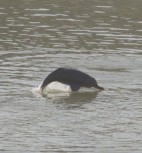 The Indus River dolphin is one of the world’s rarest mammals that is critically endangered with an estimate of 1000 living in the wild as reported by IUCN. The Indus River Dolphin has a long beak and a stocky body. It has a low triangular hump on its back in place of a ‘true’ dorsal fin. It is gray-brown in color, sometimes with a pinkish belly. The eyes are extremely small, resembling pinhole openings slightly above the mouth. The Indus River dolphin measures between 1.5 – 2.5 m (5 – 8′) in length and weighs 80 – 90 kg (180 – 200 lb). The Indus River dolphin generally occurs in the deepest river channel and is less common in secondary channels and small braids. Reported habitat preferences include channel constrictions, confluences, and deep, low-velocity water.
The Indus River dolphin is one of the world’s rarest mammals that is critically endangered with an estimate of 1000 living in the wild as reported by IUCN. The Indus River Dolphin has a long beak and a stocky body. It has a low triangular hump on its back in place of a ‘true’ dorsal fin. It is gray-brown in color, sometimes with a pinkish belly. The eyes are extremely small, resembling pinhole openings slightly above the mouth. The Indus River dolphin measures between 1.5 – 2.5 m (5 – 8′) in length and weighs 80 – 90 kg (180 – 200 lb). The Indus River dolphin generally occurs in the deepest river channel and is less common in secondary channels and small braids. Reported habitat preferences include channel constrictions, confluences, and deep, low-velocity water.
The Indus River dolphin feeds mostly on several species of fish and invertebrates. It does much of its feeding at or near the bottom, using echolocation, swimming on one side, and probing the river bottom with its snout and its flipper. Although it is not usually considered to be gregarious, relatively high densities are found at sites where rivers join, in areas where the current is relatively weak, off the mouths of irrigation canals, and near villages and ferry routes.
The Indus River dolphin is endemic to the rivers of the lower Indus River basin in Pakistan. Historically, it ranged from the Indus delta upstream to the Himalayan foothills where rocky barriers or shallow water prevented further upstream movement. Currently the distribution of the Indus River dolphin is severely fragmented and dramatically reduced in extent. The linear extent of its occurrence has declined from approximately 3,400 km (2100 mi) of Indus River mainstem and its tributaries in the 1870’s to approximately 1,000 km (600 mi) of the mainstem at present. Currently the Indus River dolphin is limited to three subpopulations in the Indus mainstem located between the Chashma and Taunsa, Taunsa and Guddu, and Guddu and Sukkur Barrages. (IUCN 2006)
The main reason for the decline of the Indus River dolphin was the construction of numerous dams and barrages, starting in the 1930’s, that have fragmented the population and reduced the amount of available habitat. Another severe threat to the survival of the Indus River Dolphin is probably the increasing withdrawal of water. Dolphins no longer occur in the lower reaches of the Indus because upstream water extraction leaves downstream channels virtually dry for several months each year.